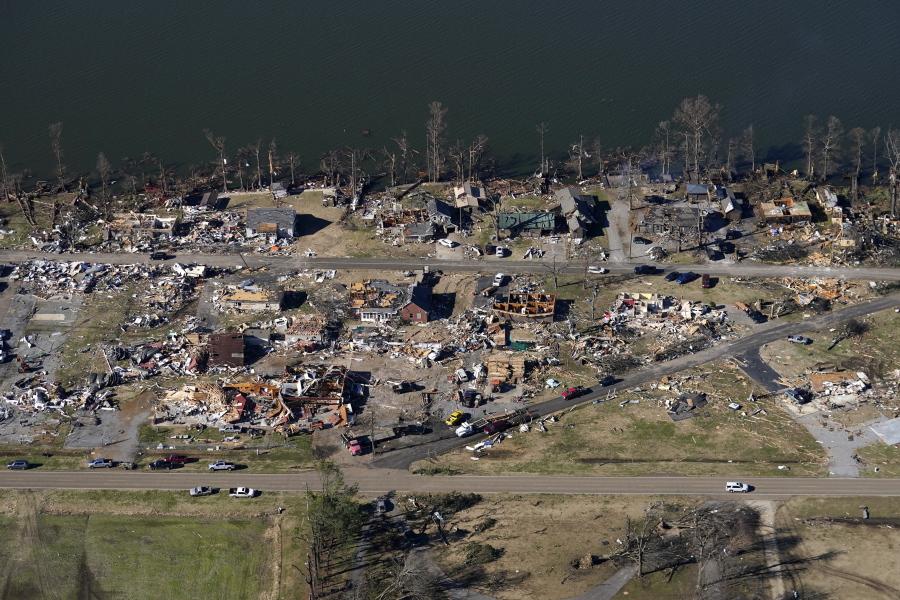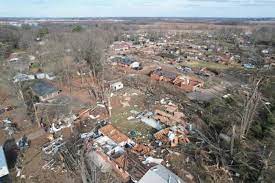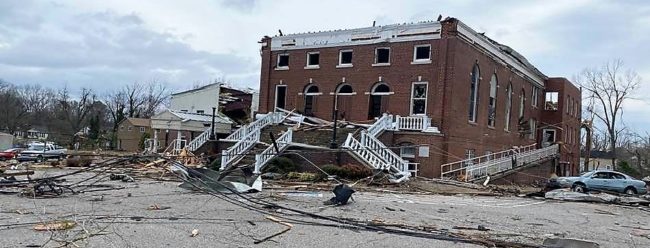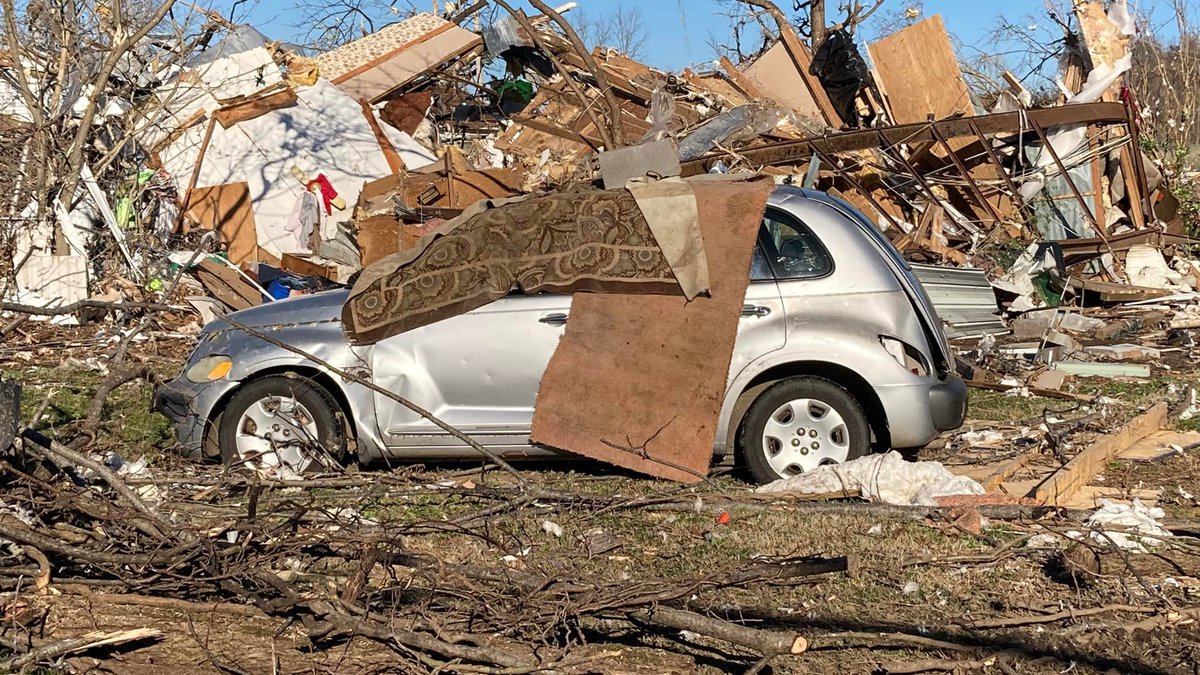Six months after fatal tornados, Tennessee cities still recovering

By KATE COIL
TML Communications Specialist
Six months after a major storm system and tornado outbreak struck five states and led to the deaths of 89 people, Tennessee cities are working to recover from severe damage that changed their communities forever.
The storm system would rip through five states during the late evening of Dec. 10, 2022 into the early morning of Dec. 11. Five major cells in total brought an estimated $3.9 billion in damage and led to 71 confirmed tornadoes through five states. Two of these cells passed through Tennessee.
The first major cell to hit was an EF-4 tornado that originated in Arkansas and the Missouri bootheel region. This storm reached its second peak near Tiptonville and Samburg along Reelfoot Lake, resulting in three of the four fatalities of the storm reported in Tennessee. In addition to the EF-4 parent storm of the super cell, another EF-1 and an EF-0 tornado were recorded between Samburg and Union City. The cell progressed northwest of Union City near Woodland Mills before heading to Illinois.
Samburg Mayor John Glessner said city officials and local residents had been tracking the deadly F-4 tornado since it originated in Arkansas .
“We have had several close calls in this area over the past two or three years,” Glessner said. “Earlier that year in May we had pretty severe damage from a tornado or straight-line wind storm, so we had just finished getting cleaned up from that when this tornado hit. Obviously, it’s surreal. You hear the stories of how they sound and the damage that can take place, but you can’t really appreciate the severity of the situation until you are actually standing in the debris field. The carnage is unbelievable of what mother nature can do.”

The third cell of the event and second to hit Tennessee began near Newbern, intensifying to an EF-2 before striking in Kenton as an EF-3. The storm weakened as it passed through Sharon but again began to strengthen as it approached Dresden, hitting downtown as an EF-3 and continuing through Cottage Grove before entering into Kentucky.
Kenton Mayor Danny Jowers said the previous storms that day had led to many residents knowing they needed to take cover at their homes or in local shelters, which helped prevent loss of life in the community. The area of Kenton that was struck was primarily residential, but damage to utilities wound up impacting more areas of the community.
“The town was cut in half,” Jowers said. “You couldn’t get from one side to the other. If you were coming from the northside of town, you had to drive out of the way to get to the southside of town. It was a logistics nightmare. Thank goodness most of the help game from the south end. We are a town split by the county line, so half of our town gets its electricity from one utility and the other from the other. While only about a quarter of the town was hit by the tornado, all of the electrical infrastructure was destroyed. There were areas not hit by the tornado that had no electricity for almost seven days. It was odd coming in because the north side of the town was lit up, but once you crossed the county line everything went dark. The tornado dug into the ground and dug into a couple of our water mains, and we couldn’t get in there to cut them off. It completely drained our water tanks. ”
The same storm that hit Kenton then made a direct hit on downtown Dresden, leaving damage to nearly 200 structures, including more than 100 homes, 21 businesses, and municipal infrastructure. Dresden Mayor Jeff Washburn said the city was fortunate no lives were lost and there only a handful of significant injuries from the storm in Dresden.
“We did lose our city hall, our police department, and fire department buildings that were located in the downtown area,” Washburn said. “We were fortunate it hit at 11 o’clock at night rather than during the day when a lot of people are downtown in the courthouse, city hall, and those businesses. My family and I were in the basement of our house, which was in the direct path of it. We had several of our children and grandchildren in the basement with us. We noticed when we opened the door that the cars were thrown around and the garage was gone. There were trees and electric lines down. It was total chaos there for several hours just trying to get the streets where we could get the emergency crews down them.”
The combination of the storm hitting at night and the fact that Samburg caters to numerous tourists could have easily complicated search and rescue operations. However, Glessner said early warnings to residents and visitors helped save lives despite the town taking a direct hit. Within a half hour of the storm, Glessner said local officials began organizing to assess the situation and ensure everyone was accounted for.
“We are a small community of several hundred, but we are a big tourist destination since we sit here on the banks of Reelfoot Lake,” he said. “We have hundreds of tourists in the area at all times. Because we are a tourist town, one of our biggest concerns was a head count. The first several hours were going house by house to make sure everyone was identified and accounted for. We had to see what tourists were in town and if they were accounted for.”

Washburn said quick thinking by local police and fire officials meant the city didn’t lose all of its emergency services infrastructure with the destruction of its city hall, police headquarters, and fire department.
“They had dispersed three fire trucks away from the station that took a direct hit, which was smart on the part of our fire station,” he said. “It kept us from totally losing all of our fire fighting apparatus. The police department likewise was out and about prior to the storm. The biggest thing that amazed me was that I walked around – there was no driving around – that night, and I saw the mutual aid response from our surrounding communities. It was really beneficial to have them in our time of need.”
Washburn said there were some streets in town where one side was completely demolished and the other was intact.
“I was with my pastor and we walked around until about 6 a.m. that morning,” Washburn said. “I went home, got an hour’s sleep, and came back out. The biggest thing to me was the total extent of the devastation our community had suffered and the number of buildings that were destroyed, including the entire southside of the courthouse square where our municipal buildings were. Today, that has been totally demolished and it is down to bare earth waiting for construction to start. It was amazing how much debris was thrown about in such a small area.”
The real assessment of the structural damage couldn’t begin until about 10 hours later when the sun began to rise. Glessner said Samburg lost around a quarter of all of its housing and the complete municipal infrastructure including city hall, the fire department, and water and sewer departments as well as associated equipment including the police vehicle and public works equipment. Within 48 hours, Samburg had established a command center and donation center, begun clearing local roads to allow for emergency vehicles, and started working with TEMA and FEMA.
“I’m very proud of the effort in and around this community,” Glessner said. “I think Samburg can be used as a model in how you handle yourself and act in this kind of situation. We did very well with our organizational skills, with our volunteerism, and I’m proud of everyone who was involved.”
In Kenton, Jowers said the storm downed many trees that were 100 or 150 years old, making it hard to see damage until they were cleared.

“I grew up in this town, so it was a real shock,” he said. “There was major damage to houses. There were probably 26 to 30 structures that were entirely demolished, which is a lot in a small town. The next day, people were bringing in trucks, backhoes, trackhoes, and you name it. Our sister cities were bringing in their resources to help us clean up. The cleanup started that night. We had farmers, private citizens, and other cities who sent all kinds of resources here. The biggest thing was getting the roadways cleaned up and opened. Once we got the roads open, we could start addressing the electric and water issues we had that night.”
Along with cleaning up streets, Washburn said Dresden officials had to find where to move their own operations temporarily.
“We were able to restore our city hall operations by moving it to our civic center on a temporary basis,” he said. “Our fire department has located its trucks and things out to some garage space that is loaned to us while our police are operating out of a cramped office space in our civic center. The city was able to get back online in a couple of days with our computers to keep up with our utility billing and things like that.”
Six months after the storm, Glessner said Samburg is continuing to work with government agencies to help rebuild both the community and the local government facilities. Debris from both the town and surrounding county is being gathered and processed at a local ballfield, and Glessner said nearly all the heavy debris has been processed. Approximately 75,000 cubic yards of debris has been processed.
While bad weather and supply chain issues have increased expect recovery times, Glessner said there are 16 houses expected to be built in the next 18 months – perhaps the most that have ever been under construction in the small town at the same time. The town has used disaster funds to replace most of its municipal equipment. Local government continues to operate out of temporary buildings, but a silver lining is that the storm has allowed plans for a more consolidated municipal complex.
“We have a plan to secure a single location to house our fire department, city hall, water department, and police department all under one roof,” he said. “We have seen several other cities do that in the past. Before this, we had all of our departments in different buildings. We have put that on the table with FEMA, and they like that idea. We believe we can build a single site cheaper than we could put four or five buildings back in their locations. We also have plans to put in a storm shelter that would house our community because we are in the path of Tornado Alley now.”
Jowers said supply chain issues have also complicated the long-term recovery in Kenton.
“The cost of building materials is so high and there isn’t the labor you need to build,” he said. “There are a lot of empty lots right now. People want to rebuild, but for modular homes its two years behind and 18 months on contractors coming in to build. That is our challenge now is to get things rebuilt. There have been a lot of properties sold. These were older people who lived here their whole lives. They aren’t going to stay and rebuild. The area will never look the same again, and that’s just the way it is.”
In Dresden, plans are being made for a new municipal complex in addition to private rebuilding.
“We are ready to start picking up all the debris that needs picked up once FEMA approves our contract,” Washburn said. “We have some houses already under construction. We have two or three businesses that have already begun rebuilding, two have already opened for business, and we have two businesses that have made announcements they are coming to our community since then. We are working with architects and engineers to build a municipal complex that would encompass city hall, the fire and police departments under one structure. We have acquired some additional space and are working to acquire two more lots where businesses were previously located to build our city hall. We are looking at a 20,000-square-foot municipal complex.”
Six months on, officials said the tornado has helped bring their communities together.
“You never know how you are going to react in this kind of situation until you are put in it,” Glessner said. “This entire community stepped up in a way that would make anyone proud. We are well on our way to recovery. It reaffirms what you hope would happen, but you never know until you know.”
Jowers said support from other cities has also been invaluable.
“I knew we would come together, and I was pleased to see other cities coming to help us and get us back on our feet as soon as we could,” Jowers said. “That was the biggest thing.”

